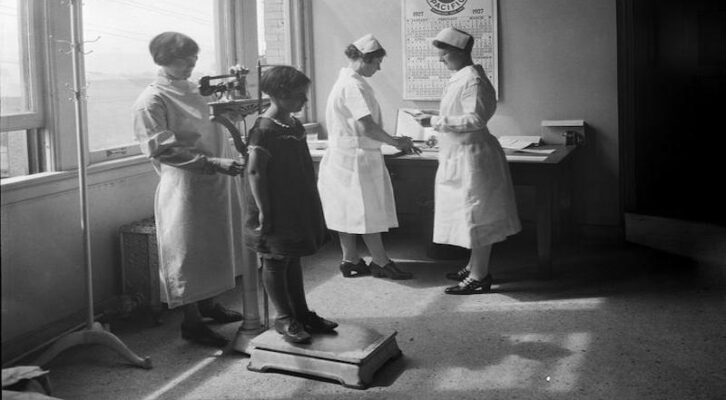
As I Lay Dying: Five Books that Reckon with Illness and Time
Maria Smilios Recommends Samuel Beckett, Elizabeth Tova Bailey & More
At 22, I became enthralled with Samuel Beckett’s Waiting for Godot and the two vagabonds who wait on the side of a road in a post-apocalyptic world, searching for something to do to pass the time. To fill the hours, they tossed their hats, argued, reminisced, told bawdy jokes, thought about suicide, threatened each other, asked rhetorical questions, and lapsed into silence, until the day ended, and they began again.
Intellectually, I understood the play: Beckett was suggesting that if we had no meaning, no shape to our days, time became “a great deadener.” But the more visceral impact of the play evaded me until two years later, when my mother was diagnosed with stage four breast cancer. At first doctors gave her three months, but she lived for almost two years. During that last year of her life, I watched her spend entire days like the vagabonds, looking for things to do. When her efforts failed, she, like them, quieted, and fell into prolonged silences.
“What do you think about?” I once asked her. “Trying to fill the time with something purposeful until it stops,” she said. “Some days I look at the leaves shimmering in the sunlight or listen to the wind. Other days, I pick at my nails or tell myself long stories like Scheherazade.”
My mother wasn’t alone in her struggle. Two years after being diagnosed with Hodgkin’s lymphoma, eight blocks away, my closest friend, Carolyn, was dying. “The hardest thing about dying,” she told me one gray January day, “is finding something that will make you stop remembering you’re dying.” She, like my mother, had tried watching the sky and the trees, listening to the kids outside, and recalling the meager 23 years of her life. Years later, my father too would lament his desire to fill the hours with something consequential. “I wish I had more time,” he said, “but not this kind of time, this sick time. It’s horrible.”
Eventually, my mother found something to occupy her mind and hands: unraveling an old knit blanket, thread by thread. Carolyn too found her way through the hours, and so did my dad. One doctor told me this was “an acceptance” of their fate, a recognition that they were dying. I didn’t believe him, at least with my mother. At 47, she didn’t want to die.
My book, The Black Angels, deals intimately with death, or dying, as it chronicles the courageous Black nurses who stood on the front lines in the fight against tuberculosis at Sea View Hospital, a behemoth municipal tuberculosis sanatorium in Staten Island that housed 1,800 of New York’s poorest residents. Those stricken with TB spent their days lay in iron-framed beds languishing from what was then an incurable disease and renowned for annihilating the body in unthinkable ways. The microbe had evolved to torture and kill very slowly, leaving those afflicted with a lot of time to fill.
While writing, I thought about my readers, how I wanted them to pause and sit bedside with the sick and the dying and reckon, if even for a moment, with their own mortality; to see and feel and think about what it meant to live in a body that was fading away.
To do so, I turned to books that had been written about illness and the seemingly unpassable hours that trudged on while the body failed more and more each day. The five books below reckon with time and mortality in different ways: a woman battling a mysterious illness watches a snail; a former magazine editor blinks his eyes to communicate; on a farm in rural Massachusetts, an 87-year-old man spends his last eight days recalling his entire life; a newly minted neurosurgeon with incurable lung cancer finds his greatest joys in watching his newborn daughter; and in 19th century Russia, an aristocrat screams into the darkness hoping to thwart off death.
*
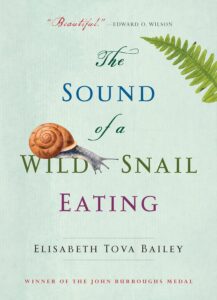
Elizabeth Tova Bailey, The Sound of a Wild Snail Eating
Elizabeth Tova Bailey’s memoir The Sound of a Wild Snail Eating, is a gorgeous meditation on finding meaning while suffering from a punishing illness. This slim 120-page book opens with a fantastic scene in which her friend brings a snail to put in the violet plant on her nightstand. Bedridden with a bacterial infection, Bailey is confused by the gift as she has little interest in snails. There she is, stuck with a body that’s gone haywire, a tiny snail, her mind, which “runs like a bloodhound,” and the daunting task of finding ways to “get through each moment.”
To her surprise, as the snail settles in and she continues contemplating her life, she develops a fascination with the tiny nocturnal creature who “moved leisurely,” who pondered “its circumstances,” “waved its tentacles,” and could even be heard as it ate! Soon it becomes her companion, a guide releasing her from the tedium of human visitors and leading her from the white walls of her room into another world: “If life mattered to the snail and the snail mattered to me, it meant something in my life mattered, so I kept on…”
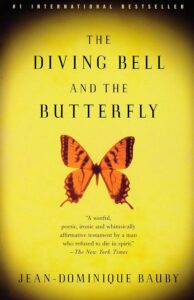
Jean-Dominique Bauby, The Diving Bell and the Butterfly
The Diving Bell and the Butterfly is another slender book that tells the story of Jean-Dominique Bauby, a well-known French journalist and editor of Elle magazine. At 45, he suffered a massive stroke that caused locked-in syndrome, a condition the paralyzes the body but leaves the mind intact. When Bauby finally woke from his coma, he’d lost the ability to speak and move any part of his body except his neck and his left eye.
While lying in bed hearing machines beeping and watching as people moved around him, often touching and turning him in ways that he hates, he becomes determined to restart time, which he said had become motionless: “in my contracted world, the hours drag on but the months flash by.” The way out of this stagnant state is to tell the story that lives in his head. His nurse becomes his translator by standing in front of a board, reciting the alphabet until he blinked at the correct letter.
What emerges is pure poetry, brush strokes that paint a picture of a man closed off from life, save for the memories that flutter in his mind’s eye with the quickness of a butterfly, and because of the slow process of reciting and blinking, he can only capture snippets. But what falls on the page is exquisite and draws us deeper into his paradox: the anguish of his condition and the joy of writing: “Capturing the moment, these small slices of life, these small gusts of happiness, move me more deeply…”
One of the patients I interviewed for my book reminded me of Bauby’s story. She came to Sea View to die but survived. For months, she lay in the “incurable ward” racked with fever, unable to move, measuring the hours by staring out the window “at the shifting sky and recalling her moments of her life”— these she said, “made me want to keep living.”
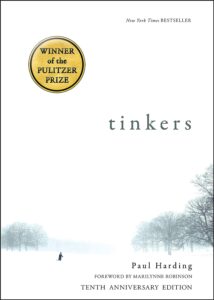
Paul Harding, Tinkers
Paul Harding’s Pulitzer Prize-winning book, Tinkers, tells the story of George Washington Crosby, a clock repairer, who lays dying in his living room. Surrounded by his kids, Crosby spends the last eight days of his life drifting in and out of consciousness, recalling the ecstasy and agony of his upbringing in Maine in early 1900. His memories, delivered in elegiac prose and steeped in the natural world — light and shadows and trees — contemplate the impermanence of time and reality, something Crosby desperately fears: “I will remain a set of impressions porous and open,” he says, and then slips back into memory, as if there he will solidify the image.
When his life comes to an end, Crosby finds solace in understanding that life is a series of fleeting moments, flashes of light that shine bright and fade away, and it’s the moment that matters, not what happens after: “Everything is made to perish…What persists beyond this cataclysm of making and unmaking?”
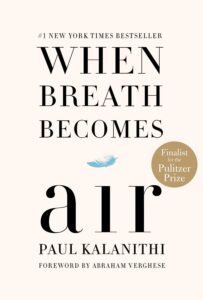
Paul Kalanithi, When Breath Becomes Air
This searing memoir that follows the author’s diagnosis of terminal lung cancer at age 36 — just after finishing ten years of medical school for neurosurgery — through to his death two years later. (I should note that he died before finishing the book, but his wife completed it). Although the book is tragic, Kalanithi’s story “is not a tragedy,” as his wife says, because it is more about living than dying. He struggles with magnificent existential questions – most notably, “What makes life meaningful enough to go on living?” – and arrives at an answer: he and his wife decide to have a baby.
Kalanithi’s hours are filled with something deeply profound and difficult but also joyous: watching his infant daughter Cady live while his own body collapses into decay. At Sea View, I heard many stories of mothers who were in Kalanithi’s position, watching their children teem with life as their own body failed, and while devastating, it was also the impetus to keep living in that moment. As Kalanithi reminds us, “There is a moment, a cusp, when the sum of gathered experience is worn down by the details of living. We are never so wise as when we live in this moment.”

Leo Tolstoy, The Death of Ivan Ilych
This masterpiece tells the story of a judge, Ivan Ilych, who has never thought about mortality until the day he finds himself dying. Lying in his room with a gnawing ache in his side, Ilych struggles to discover whether he’s truly lived, as those around him grow impatient that he’s not dying quickly enough.
As he turns inward and contemplates his life, he struggles with that insidious thing called Time: “Morning or night, Friday or Sunday, made no difference, everything was the same: the gnawing, excruciating, incessant pain; that awareness of life irrevocably passing but not yet gone; that dreadful, loathsome death, the only reality, relentlessly closing in on him; and that same endless lie. What did days, weeks, or hours matter?”
Ilych cannot find solace in ephemeral things — sunlight, memories, visitors, snails. Instead, he marks the hours through the unrelenting pain that drags him deeper into the abyss of himself, causing him to scream “Oh” for three straight days. When he finally stops shouting, he has a reawakening, that moment of clarity that Kalanithi found in his daughter and Bailey in the snail. This is not the end of life — which will go on without him — but it is the end of death: “Death is finished, he said to himself. It is no more!”
__________________________
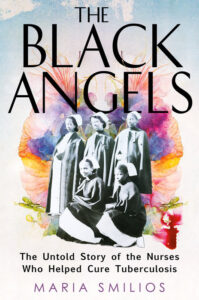
The Black Angels: The Untold Story of the Nurses Who Helped Cure Tuberculosis by Maria Smilios is available from G.P. Putnam’s Sons.
Maria Smilios
Maria Smilios learned about the Black Angels while working as a science book editor at Springer Publishing. As a native New Yorker and lover of history, medicine, and women’s narratives, she became determined to tell their story. In addition to interviewing historians, archivists, and medical professionals, she spent years immersed in the lives and stories of those close to these extraordinary women. Maria holds a master of arts in religion and literature from Boston University, where she was a Luce scholar and taught in the religion and writing program. In her free time, she enjoys reading, hiking, and hanging out with her tween daughter and their rescue dog, Buddy. The Black Angels is her first book.



















